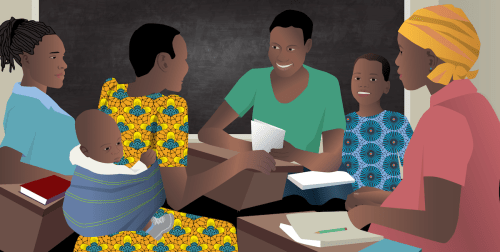This commentary is the first in a two-part series. This post reviews the history of CUE’s work on costing and financing in education and ECD and the second introduces an initial mapping of others’ work in the field.
As our team plans for its next phase of work, we have been taking inventory of a decade and a half of research and engagement focused on costing and financing in the global education and early childhood sector at the Center for Universal Education (CUE) at Brookings. We have also been examining the sector to identify recent and current globally focused initiatives and programs that explicitly seek to strengthen capacity, build knowledge, and engage with and inform actors on these issues. Our aim with this exercise is to highlight progress, note existing gaps, and identify complementarities and potential synergies between initiatives to inform our own future work and that of colleagues in the sector.
Why does work on costing and financing continue to be important?
Millions of young children and youth across the globe are at risk of not reaching their full potential in adulthood. The disruption to education caused by the COVID-19 pandemic resulted in a profound impact on learning; before the pandemic, over 50% of students in low- and middle-income countries were experiencing learning poverty. This number is estimated to have risen to 70%. Among the youngest children, the next generation to enter primary school, it is estimated that 37% globally—over 300 million—won’t reach basic reading goals by 2030 unless the current trajectory is disrupted. The magnitude of this learning crisis is such that over $17 trillion in lifetime earnings in present value, or the equivalent of 14% of today’s global GDP, will be lost.
Despite the challenges of the past few years, education spending worldwide hasn’t increased as needed. In 2022, education spending in LICs and LMICs was below 2019 levels, and just 1.4% of education aid was spent on pre-primary education, with only 10% of that aid to pre-primary education spent in low-income countries. Furthermore, direct aid to education remained stagnant and bilateral aid to education declined by nearly $340 million in 2020. With the global crisis for young children and youth growing ever more urgent, there must be a push for more equitable, efficient, and effective financing. This will require greater availability, transparency, and use of costing and financing data at both macro and micro levels. A historical dearth of cost data has hampered governments, funders, and implementers around the world from securing additional funding and improving the quality of education and early childhood development opportunities. Similarly, relatively little information on the effectiveness of alternative financing models prevents progress in these areas. Further research, data, dissemination of tools and toolkits, capacity strengthening and communities of practice in costing and financing will be critical to disrupting the current crisis.
A review of CUE’s costing and financing work
Research on education financing began over a decade ago at CUE. In 2011, Justin van Fleet published a groundbreaking report examining the role of corporate philanthropy in global education finance. The team’s in-depth research on the state of corporate philanthropy for education culminated in ten concrete policy recommendations. These inspired global children’s charity Theirworld to establish the Global Business Coalition for Education in 2012, an initiative that aimed to harness the strength of the business leaders to advocate for and support the sector.
Soon after, a report by Liesbet Steer and co-authors focused on the role of multilateral donors in education financing, noting the need for significant commitments. Two years later, as it became clear that learning goals were far from being met, CUE published a report focused on domestic finance for education. In response to this call to action, the Education Commission, co-convened by four heads of state and the Director-General of UNESCO, was established in 2015 with the goal of reforming and increasing the volume of investment in education. The commission’s report, The Learning Generation: Investing in education for a changing world, was a call to address the learning crisis through various policy recommendations, some of which focused specifically on finance. The resulting International Finance Facility for Education for example, was established with the intention to leverage donor funding to increase domestic investment in education in lower-middle income countries.
During the time of the establishment of the Education Commission, CUE shifted the focus of its work on education finance to innovative finance as well as the role of public-private partnerships and non-state actors in education. Under leadership of scholar Emily Gustafsson-Wright, the team became a leading voice on the potential use of outcomes-based finance as a pathway to more effective funding for education and early childhood development. In fact, CUE contributed a background paper for the Learning Generation report on the topic of using social and development impact bonds, a form of outcomes-based financing, to harness impact investing capital to strengthen service delivery, measurement, and collaboration among education stakeholders. As a result, the Education Commission then supported the creation of the Education Outcomes Fund, now a UNICEF-hosted Trust Fund, which pools funding to be used in outcomes-based financing models in several countries.
Costing and cost data has also been central to the work at CUE. The Childhood Cost Data initiative, established in 2014, has aimed to build global momentum to generate quality, comparable cost data on programs seeking to improve cognitive, psycho-social, nutritional, and health outcomes of all children and young people. With this goal at the center, the initiative strives to generate new data and evidence, identify the barriers to costing, and put solutions into practice through the development of tools and resources for cost collection and analysis. In 2016, CUE developed the Standardized ECD Costing Tool (SECT) aimed at providing methodological consistency to costing a range of early childhood development interventions and designed to generate costing data to be used by policymakers, donors, program implementers, and researchers to inform effective investment decisions. CUE then built upon SECT to develop the more user-friendly Childhood Cost Calculator (C3), an online, publicly accessible costing tool that provides a range of calculations, estimates, and simulated costs of programs focused on children and youth across the education, health, and social protection sectors. The tool and its accompanying Cost Data Explorer, a cost database, are currently global public goods that are being utilized in a variety of contexts in ECD and education. This phase of the initiative also included the establishment of the Global Education and ECD Costing Consortium in partnership with the ECD Action Network. This consortium brought together researchers to define and tackle broad challenges around technical and policy barriers to a lack of quality, consistent costing data for programmatic, policy, and strategic decision-making.
Looking ahead
In the next phase of work on costing and financing, CUE is working collaboratively with key stakeholders around the world to tackle the barriers preventing implementers and governments from effectively collecting and analyzing their own cost data. As part of this effort, CUE is launching “costing labs” in partnership with local actors, aimed at empowering local implementing actors and/or governments to make data-driven decisions, ultimately improving their efficiency and impact. By expanding the use of C3, the labs will also contribute to the global database of consistent cost data for young children and youth. In addition, CUE plans to establish the Global Costing Taskforce (the “Taskforce”) to address the lack of global coordination and aligned methodology regarding costing and other systematic challenges causing the scarcity of quality cost data at both local and global levels in the ECD and education sectors.
To be able to invest equitably, efficiently, and effectively, we need to know not only what works, but also how much is needed to achieve those goals and how to best allocate funding. This is going to necessitate:
- More and better cost data, which in turn will require:
- An appreciation of the importance of cost data
- Access to tools and resources related to cost data
- Greater capacity to collect, analyze and use cost data
- Higher demand for and standards on the quality of cost data
- Coordination across education and early childhood actors around costing
- Harmonized methodology and terminology related to cost data and analysis
- More and better financing, which in turn will require:
- More and better cost and financing data
- Access to tools and resources related to financing
- Greater capacity around alternative financing models
- Targeted commitments by domestic governments and donors
- Improved data on the effectiveness of alternative financing models
- Defragmentation of funding in the global education and ECD financing architecture
In the second blog post in this series, we will share our initial findings from our mapping exercise examining initiatives, like ours, that are attempting to address some of the issues outlined above. Any thoughts or inputs into this research can be shared with us at [email protected].





Commentary
Taking stock of key contributions toward enhancing global education and early childhood costing and financing: Part 1
September 25, 2024